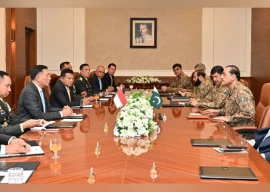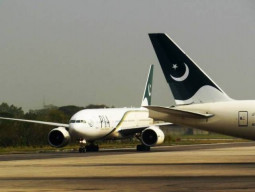
But nearly 70 years into partition the two nuclear-armed neighbours have hardly shown any inclination to combat the problems of poverty, environmental degradation, and gross social inequalities that they jointly face .
For one fifth of humanity (population of India and Pakistan) issues like multi-dimensional poverty, illiteracy, disease and lack of access to basic facilities like sanitation, clean water, drainage, unemployment assume greater importance than issues that are supposed to divide the two countries like Kashmir, Siachin, etc .
More than 440 million people in India live below poverty line — ie, on less than $1.5 a day
In absolute terms more than 42 per cent of India’s population earns less than 78 pence a day. More than 24 per cent Pakistanis share the same fate.
A United Nations report on global poverty reveals 53.7 per cent Indians and 49 per cent Pakistanis suffer from multi-dimensional poverty — a term that incorporates such other factors as schooling, child mortality, nutrition, access to electricity, toilets, drinking water and hygienic living conditions.
Pakistan adopted a new poverty line last year according to which 60 million Pakistanis live below poverty line.
Geography would dictate a common approach, based on respect for each other’s rightful share of water in the distribution of water from rivers which emanate from Indian territory and flow through Pakistan .Water sharing is a matter for life and death for both countries. Pakistan is on its way to becoming a water stressed country very soon .The forecasts are alarming .India faces a somewhat similar prospect.
According to the Indus Waters Treaty of 1960 — brokered by the World Bank — India was granted exclusive rights over the three eastern rivers — the Sutlej, the Beas and the Ravi — and their tributaries before the point where the rivers enter Pakistan while Pakistan won the rights over the waters of the Western rivers — the Indus, the Jhelum and the Chenab and their tributaries. Pakistan’s share of the total Indus system is over 80 per cent which makes India a beneficiary of less than 20 per cent.
But controversies over construction of storage reservoirs upstream continue to sour relations. As water quantity dwindles and the demand — largely because of population growth — increases the water sharing would pose many problems. Perhaps this would emerge as an explosive issue that could lead to a conflict or war between the two countries.
As the Himalayan glaciers begin to melt and global warming takes hold, with alarming consequences for both countries, the issue of climate change would assume crucial relevance because soil erosion, prolonged droughts, drying up of aquifers — all would severely impact lives of humans and livestock.
The issue is not only a fairer distribution of water. It goes much beyond that objective. The two countries are mandated by fate and destiny to collaborate and coordinate efforts — at all levels to deal with the menace of ecological looming disasters. Because nature has so shaped the environment — the physical terrain, the rivers, the mountains that only joint, well-coordinated endeavours could contribute to the objective of protecting the environment and avoiding a precipitous collapse of the fragile eco-balance that looms on the horizon.
The key issues that both countries face and are imminent: loss of biodiversity, high population density, limited access to potable water urbanisation, prevalence of water-borne diseases, weak urban infrastructure, water pollution that also gravely affects fish industry, industrial soil degradation, deforestation, etc.
These are issues that would seriously undermine the myriad government initiatives in the sectors of education, health, agriculture, fishing, industry and economy.
For obvious reasons and because of physical connectivity these menaces could only be addressed by undertaking collective efforts with a view to saving lives and safeguarding the natural treasures of water, forests and trying to restore — to the extent possible, the ecological balance that is under assault .
By a joint strategy that excludes considerations of hegemony, control or monopoly, the two countries can achieve the full potential of their enormous resources. The Indus river basin has a potential of producing 34,000 megawatts of electricity. India has already been able to generate more than 11,000 mw of electricity through projects on utilisation of the Indus river potential. Many more projects are in the pipeline. But these projects could be designed in consultation with Pakistan in a spirit of understanding and accommodation that takes into account the legitimate interests of the people of the two countries.
That can only happen when there is an environment conducive to mutual trust.
As relations remain sour and hostility drives the policies and perceptions of both countries, there is no hope for a future that would bring economic prosperity and help save the environment from the imminent danger of destruction of the eco system.
When so much is at stake is it prudent or rational to continue on a belligerent path that promotes more hatred and breeds more acrimony? Only because the issue of Kashmir remains unresolved .While the issue of Kashmir must be addressed and resolved, is it fair to bind the destinies of 1.4 billion people with the question of autonomy for 12 million?
Islamabad must understand that a country of the size of India would never agree to the changing of the borders. Musharraf conceded this in his four-point formula. That leaves us with the only other option of helping the Kashmiris to seek greater autonomy within the existing international frontiers.
Presumably India would not be averse to such a solution.
Any alteration in the boundaries would create a chain reaction with potentially catastrophic implications for India and the whole region. Pakistan must factor this reality into its calculations while trying to champion the cause of Kashmiris.
For millions of the poor, destitute people of the sub-continent the issues of economic survival, of education, of drinking water, of electricity, of jobs, of healthcare and housing are more pressing, more real than “more autonomy” for Kashmir, although the issue of autonomy can not be relegated to the background. The status quo in Kashmir is no longer an option.
Published in The Express Tribune, February 3rd, 2017.
Like Opinion & Editorial on Facebook, follow @ETOpEd on Twitter to receive all updates on all our daily pieces.














COMMENTS
Comments are moderated and generally will be posted if they are on-topic and not abusive.
For more information, please see our Comments FAQ